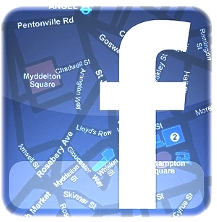 There will be consequences if you don’t understand the rules and the stakes of Facebook Places. Love it or hate it, you’ll need to understand it. So listen up.
There will be consequences if you don’t understand the rules and the stakes of Facebook Places. Love it or hate it, you’ll need to understand it. So listen up.
Individuals have to jump through hoops to opt out of Facebook’s new Places feature, and companies better follow the complex rules to opt in.
Places is NOT like Foursqare or other GPS services
Sounds a lot like Foursqare, Gowalla, Yelp and Booyah – until you consider that Facebook user’s typically provide far more personal details, including photos, videos, relationships, employment and educational data.
Using Facebook Places requires an iPhone. If you don’t have an iPhone, you’ll have to use the Facebook touch mobile site on a browser that supports both HTML 5 and geolocation.
The company does plan to roll out Android (Android) and BlackBerry versions of Places, but they haven’t released any specific dates for those releases yet.
Individuals: Newly launched Facebook Places – which will allow users to check-in to Places (created by both people and businesses) via the web or through mobile apps – automatically opted every user into the new service.
Unlike other location services, Facebook Places also will allow friends to check you in to places. Users who don’t want to participate have to opt out through a complex series of privacy settings, which are not all in the same place. LifeHacker has step by step instructions on how to change your settings to disable Facebook Places. Ignore this at your peril. Sigh.
Companies: Facebook is targeting businesses to advertise on the Facebook Places. Techcrunch has more details. Facebook has its (kinda lame) version of the details here.
It’s pretty easy to project that businesses will soon be able to target ads to people who have checked into their place – giving Facebook a new and enormous revenue stream.
Businesses are basically being forced to opt in to Places. Companies will need to create a new Places page, verify that they have the right to claim the Place, and then merge their Facebook and Places pages. Then there’s your Facebook-created Community Page, which Marketing Pilgrim described as “your lurking reputation nightmare.”
Businesses need a Place as well as a Page – claim it now
Facebook wants businesses to claim their place – which means you need a Place page and a Facebook Page.
“… The Place page will contain additional relevant information about the Place if it’s available. …By claiming your Place you can manage your Place’s address, contact information, business hours, profile picture, admins and other settings. …”

Once you have established your business Place, you can merge it with your Facebook page. Then “… you may target people who ‘Like’ your Place page if you have performed a Page to Place merge.” Confusingly enough, business can advertise their Place on their Page Businesses will have to “claim” their page — by responding to a phone call from a Facebook representative, or by uploading some kind of official documentation that proves they have the right to that location.
According to Techcrunch, merged Places page will include the number of check-ins, who checked-in to a place, number of Likes, the Places’ Wall, and more.
Over a million businesses have Facebook pages for their brands. They’re pretty much being forced to create Places as another marketing function:
“Places creates a presence for your business’s physical store locations- encouraging your customers to share that they’ve visited your business by “checking in” to your Place. When your customer checks into your Place, these check-in stories can generate powerful, organic impressions in friends’ News Feeds, extending your brand’s reach to new customers.”
There’s bound to be confusion as Places rolls out. Love it or hate it, but don’t ignore it.







